Ecotourism and eco travel are gaining huge popularity around the world, with new markets popping up daily within the green tourism industry. There are eco-resorts, sustainable products, vegan restaurants, natural toiletries and plastic alternatives all around the world.
It’s easy to become part of this positive movement, this Eco Travel Guide will run you through the step by step process of traveling “eco”. Including what it is, what to pack, how to travel and where to stay.
This article has been updated for 2024 to reflect the best eco travel advice, green accommodation options, and sustainable products out now.
Table of Contents
What Is Eco Travel
The act of eco travel promotes a greener type of tourism to encourage a sustainable travel future. This will allow future travelers and unique cultures around the world to continue traveling for generations to come.
There are a few key factors that this type of tourism covers. It should:
- have a minimal or low impact on natural sites and cultural practices
- have a positive impact on local communities and their economy
- encourage education and awareness of ecological sustainability
There are various terms or phrases used within eco-tourism:
- Responsible Travel
- Ethical Travel
- Green Travel
- Sustainable Travel
- Zero Waste Travel
- Eco-friendly travel
- Conscious travel
- Low-impact travel
- Slow Travel
Different types of tourism
People travel for a variety of reasons. Therefore, there are various different types of tourism. Each offers unique attractions and experiences. Some include:
- Medical Tourism
- Adventure Tourism
- Sports Tourism
- Religious Tourism
- Wellness Tourism
- Dark Tourism/Alternative Tourism
- Cultural Tourism
- Budget Tourism
- Package Tourism
- Volunteering Tourism
- Eco-Tourism
- Sustainable Tourism
- Responsible Tourism
- Ethical Tourism
- Green Tourism
- Zero Waste Travel
While there are many different types and sub-genres (that could easily blend together), this gives an indication of just how many potential types of tourism there are.
What is Eco Tourism
“Responsible travel to natural areas which conserves the environment and improves the welfare of local people.”
The International Ecotourism Society is a not-for-profit organisation that has been working since 1990 to develop guidelines and educational platforms for eco tourism. They have members in 190 countries around the world in fields varying from education to government to tour guides.
Ecotourism principals
The international ecotourism society has determined a set of “8 principles of ecotourism“. These have been taken as the guidelines on which the ecotourism industry is founded.
- Minimize physical, social, behavioral, and psychological impacts.
- Build environmental and cultural awareness and respect.
- Provide positive experiences for both visitors and hosts.
- Provide direct financial benefits for conservation.
- Generate financial benefits for both local people and private industry.
- Deliver memorable interpretative experiences to visitors that help raise sensitivity to the host countries’ political, environmental, and social climates.
- Design, construct and operate low-impact facilities.
- Recognize the rights and spiritual beliefs of the Indigenous people in your community and work in partnership with them to create empowerment.
For instance, when choosing an eco-resort, the more principles that an establishment adheres to, the more “eco” it actually is. There is a grading spectrum.
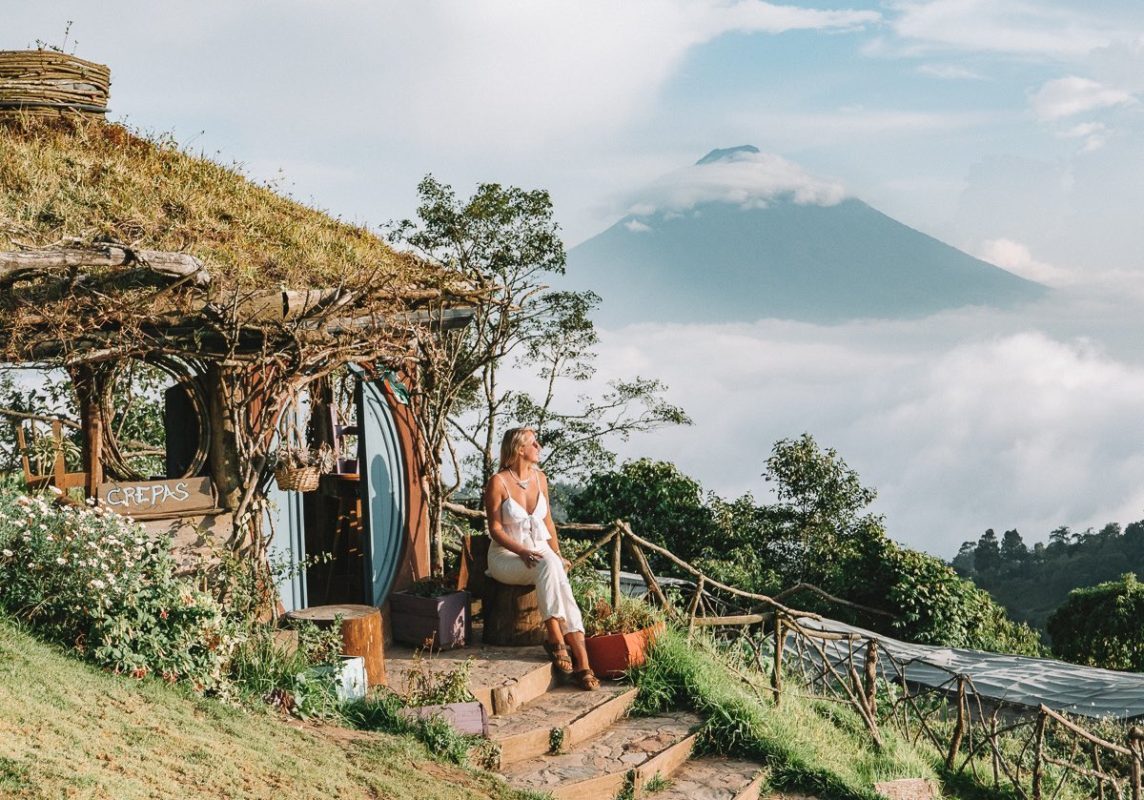
Why Eco Travel Is Important
The popularity of travel is skyrocketing. With an estimated 1.1 billion people traveling internationally each year, the effects on destinations are significant. This can be both positive and negative.
Over-tourism
The aim is to avoid “mass tourism” or “over-tourism” at tourist destinations. There have been several cases recently where sites literally had to close to “recover” from the extreme tourist load.
- Boracay, Philippines has already had to close its doors to the 2 million annual visitors it sees every year. The ecosystem can simply not handle the volume. Pollution, reef damage from trampling and water quality were all under threat.
- Maya Bay, Thailand (the island used in the Beach Movie – Leonardo DeCaprio) has had to close due to over-tourism.
- Bali, Indonesia is in a state of “garbage emergency” with around 4.5 million visitors a year heading to the small island. A new tourist tax is in consideration to help curb the over-tourism issues.
Plastic Pollution
Plastic is a serious issue around the globe. Not every city or town has adequate recycling facilities, yet tourists are drinking from single-use plastic bottles and using plastic takeaway items without being conscious of their waste footprint. With statistics like these below, it is imperative that travelers say no to plastic to avoid placing an even greater burden on the environment.
At least 14 million tons of plastic end up in our oceans every year. Many countries lack the infrastructure to prevent plastic pollution such as: sanitary landfills; incineration facilities; recycling capacity and circular economy infrastructure; proper management and disposal of waste systems
Earth Day Network (2024)
How does eco travel help?
In places like those mentioned above, drastic measures are first required, such as closing the site for all visitors. In many places, this is not economically viable for local residents who make their living from the tourism industry.
Eco Travel is focused on supporting local communities (including businesses) while encouraging and reducing environmental load.
If travel is done correctly, there should be:
- no pollution issues (as products used are environmentally friendly)
- minimal natural destruction (as eco resorts and other accommodation is built to enhance the local environment)
- minimal loss or dilution of local cultures or wildlife
The change starts here with simple changes we can make to our travel plans and practices. Following this guide will ensure that you are doing your part to help the global tourism industry.

The Ultimate Eco Travel Guide
Awareness is increasing, with more and more tourists saying they are willing to pay more for a trip with better environmental and social considerations.
The following guide can be used as a reference for all travels considered under the greenest type of tourism, Eco-Tourism! It covers the necessary actions, products, accommodation, travel types, and practices that should be considered when planning either a tour or an adventure (locally or internationally), or booking through a travel company.
1. Eco Travel Gear and Products
If you are planning to travel to a destination, you will likely pack some kind of bag. Each person will partake in different activities and require different specific needs. However, there are some travel essentials that can be used by everyone.
The following packing list is a combination of the most relevant, sustainable and user-friendly products on the market at present.
Zero Waste travel products
How many times have you been caught out without a bag for your groceries? Or had a plastic straw in your drink without asking? Saying no to plastic when we are traveling and choosing plastic free alternatives can significantly reduce your waste while traveling.
Here are the top 8 ways to avoid plastic while traveling
- Bring a Compact bag for any impromptu buys (a great alternative to plastic bags)
- Keep a Portable cutlery set in your bag
- Pack a Reusable waterbottle to keep your drinks chilled all day long
- Use a Reusable straw or ask for no straw
- Bees Wax Wraps for your packed lunches
- Keep a Reusable Coffee Cup for your pick me ups
- Bring some Cotton produce bags, these can double as clothes sorters
- Invest in a bottle with a Water filter system so you can stay hydrated on the go.
Learn more about sustainable travel products:
- Best Eco friendly travel products
- Alternatives to single use plastics
- Australian Zero waste products for travel

Eco-friendly toiletries
Toiletries are an essential part of travel. At some point, you will need to brush your teeth and clean yourself. Unfortunately, toiletries are one of the biggest environmental polluters. Plastic packaging and harmful ingredients are ending up in the ocean.
Many commercial toiletry products actually have microplastics in their design. For example, shampoos or soaps with “microbeads”. These are washed down the drain and directly impact marine life.
Going to an eco shop and swapping your toiletries to eco friendly alternatives can significantly reduce your environmental impact. Natural products, free from chemicals are also much better for your skin and health.
Eco friendly toiletries list
- Shampoo Bar – replaces the plastic bottles needed for shampoos and soaps. As an added bonus, they last a lot longer than normal shampoo in a bottle.
- Reef Safe Sunscreen – With fewer chemicals than mainstream sunscreen, this is not only better for your skin but can prevent damage to coral reefs when you swim by. (Many mainstream/commercial sunscreens contain chemicals that can cause significant damage to reefs over time.)
- Natural Deodorant – replace the spray cans or roll-ons (containing chemicals and plastic packaging) with tins containing natural deodorant.
- Bamboo Toothbrush – replace your plastic with bamboo! They come in cardboard recycled material packaging and won’t pollute the environment when you’re finished with them.
- Plastic free Toothpowder – ditch the plastic tubes for some toothpowder in a reusable glass jar.
- Natural Makeup – there are so many chemicals in commercial makeup that are not only bad for your face but not good for the environment either. With so many amazing options to choose from, the switch has never been easier. Learn how and why to avoid palm oil products here.
- Safety Razor – the plastic throw-away razors are really adding to the single use plastic waste in our oceans! The safety razor is metal and lasts a very long time!
- Essential Oils – These can replace so many different products that would normally come in plastic packaging. Some uses include: headache/pain relief, calming and sleeping improvement, digestion issues, and mosquito repellent! All these can be replaced with a set of natural oils that have no chemicals and are much better for you and the environment.
- Menstrual Cup – for the ladies. Replaces all that packaging you would normally need to carry and throw away! Save space, save waste.
Learn more:

Sustainable fashion
The fashion industry causes a significant amount of harm to the environment. Greenhouse gas emissions, microplastics, and poisonous chemicals all end up damaging ecosystems.
With more and more amazing sustainable fashion brands popping up (using organic, sustainably resourced, upcycled and ethical practices), there are even more ways to look good while you travel.
5 Tips for a Sustainable Wardrobe
- Repair, reuse, or recycle your clothing
- Shop vintage or organise a clothes swap with friends before you travel. Alternatively, borrow someone’s hiking gear, or snorkel equipment for your trip.
- Go versatile and try multiple-use and reversible clothes (perfect for making space in your travel bag)
- Invest in quality, not quantity: choose clothes that are made from natural fibers such as organic linen, hemp, ethical wool, organic cotton, and ethical silk cotton, and check that they have the Global Organic Textile Standard certification (GOTS). These are ones that have been grown with environmental protection, animal welfare, and our health in mind.
- Recycled fabrics: There may be certain times when you like to wear clothes made out of synthetic fibers (swimming in the ocean, exercising, traveling). So when you do look to purchase these items, buy from brands that use recycled fibers and natural dyes (like Eco Alf, Baiia, Toad & Co). This is a great way to upcycle some of the plastic in circulation.
- Be aware of microfibers: Use a Guppyfriend Washing Bag when you wash your clothes that contain synthetic fibers. It will catch 99% of the microfibers during the washing cycle.
2. How To Find Eco Accommodation
There are really three main “pillars” or considerations when rating and choosing an eco resort or hotel:
- Eco Accommodation and you: How the accommodation supports you to make sustainable choices. This could be signage about reducing water usage, providing you with plastic alternatives and more.
- Eco Accommodation and the Community: The eco hotel/resort employs local staff and supports the community, providing education and learning opportunities.
- Eco Accommodation and the Environment: The accommodation is aware of its environmental footprint, supports local species, and limits its impact on the natural surroundings.
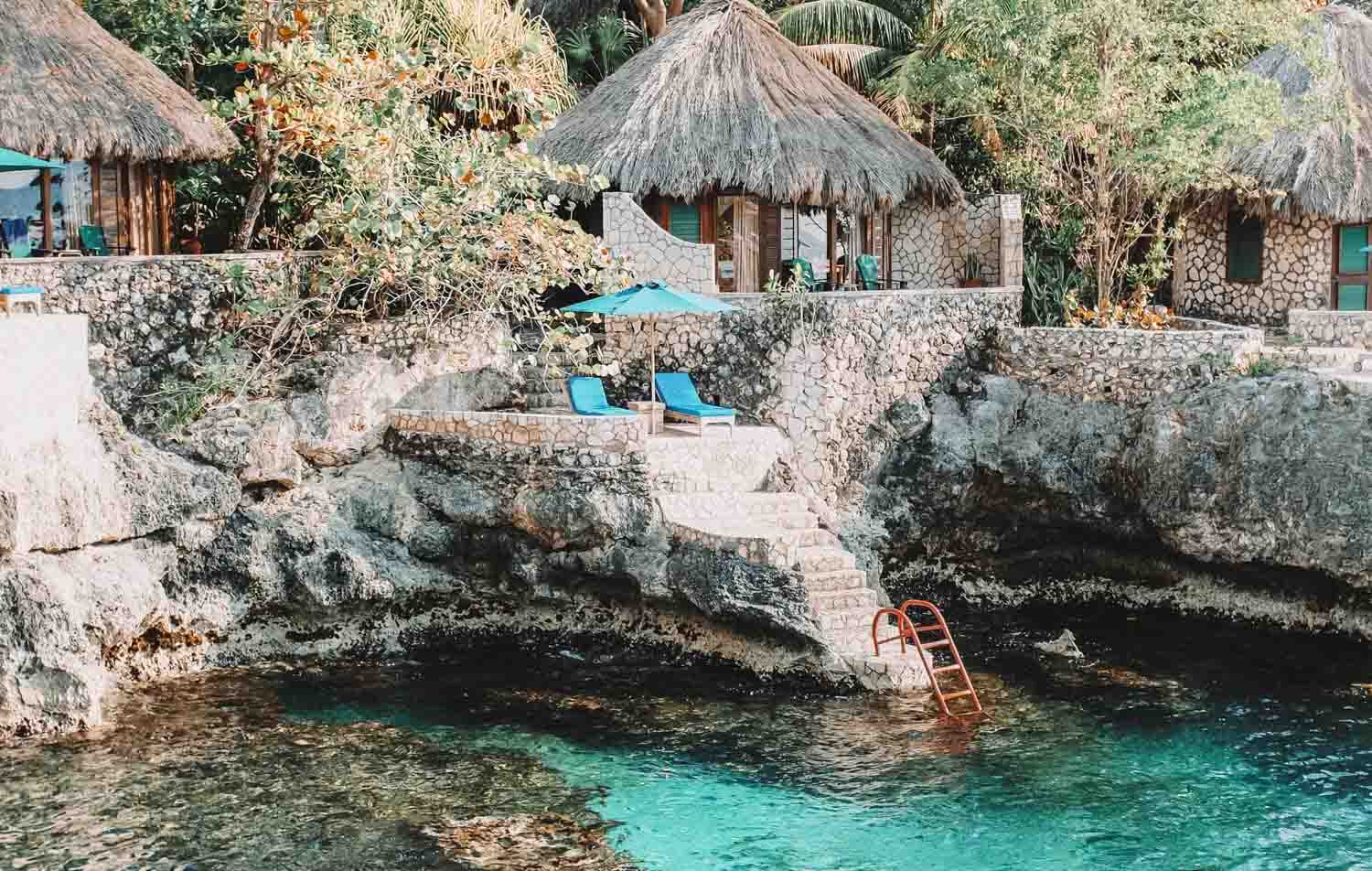
What are eco hotels?
Eco hotels are designed to exercise the principles of ecotourism. They should minimize their environmental footprint (energy, water, waste, food waste), promote the wellbeing of the local community through education and job opportunities, and care for the local landscapes and wildlife. Some amazing and unique sustainable hotels include:
- The Good Hotel, Guatemala
- La Fortuna Hotel, Guatemala
- Laguna Lodge, Guatemala
- Hobbitenango, Guatemala
- The Rockhouse Negril, Jamaica
- True Blue Bay Resort, Grenada
How to book eco accommodation?
A good place to find Eco Resorts is on Green Pearls. They have an “eco ranking” guide so that you can see where on the eco-accommodation spectrum the lodging stands. Alternatively, you can check out the top 7 platforms for eco accommodation options here.
There are other ways to travel besides staying in an “eco resort”. For those on a budget, here are some alternatives.
Housesitting or Houseswapping
Since the invention of apps like Couchsurfing and Airbnb, the world of house sharing for travelers has changed dramatically.
In general, it is more eco to stay in a house rather than a hotel. This is for a few reasons:
- If you are staying in a house, you might use light, air conditioning, or fans in one or two rooms. A hotel needs to have large areas lit and temperature controlled even if no one is using them. Hotels, therefore, have much greater energy and water footprints.
- In a house, you might buy enough groceries to eat for yourself and your guests. Hotels need to cater to large volumes of orders that may not occur. There is a significant amount of food waste.
New platforms like Housesitting provide amazing opportunities for people to stay in houses that would otherwise sit empty while the owners are away.
Volunteering
New platforms are making it easier (and safer) to volunteer your time abroad. World Packers offers a great online platform for travelers willing to volunteer their time for a free stay.
- You can offer your services to assist in building a website, helping in someone’s vegetable garden, or looking after someone’s pets.
- In return, you can get accommodation and sometimes food for free!
Camping/glamping
Camping is a great way to eco travel, and adding a few details can really enhance your experience to make it not only more eco but more “glamorous,” hence the term “glamping.” We’ve gone glamping in Joshua Tree and it is a great way to connect with nature.
Liveaboard transport
Another way to avoid large hotels and unnecessary energy/food waste while traveling is by using a form of liveaboard transport.
Sailboats are an amazing example. Powered (mostly) by wind (renewable resource), they use very low levels of energy and have very little waste.
Crewbay is a great website to check for sailboats travelling and looking for extra inexperienced (or experienced) crew to join on their travels. Often you share the cost of any fuel and meals. Alternatively, you can stay in converted buses or vans for a great eco-experience.
3. How To Reduce Waste While Travelling
Traveling can put a heavy load on the environment. It is our responsibility as travelers to not only be aware but be active in our quest for finding and preserving beautiful locations around the world.
Here are the 6 R’s of reducing waste and how they are relevant to travel in this day and age.
- Refuse: Be prepared and say no to plastic
- Reuse: Have your own reusable straw, cup, cutlery, and bag while traveling
- Reduce: Minimalism is the key to eco travel, there’s no need to buy new gear for your travels. You can reuse your wardrobe, swap clothes, or rent gear for your trip
- Recycle: Do your research before you go. Are there recycling facilities where you are going? By refusing, reusing and reducing, can you avoid items that need to be recycled?
- Rot: Food waste is a significant issue with larger hotel chains. Check which hotels have food composting or recycling programs.
- Remove: Rubbish is everywhere. You don’t have to spend your whole trip picking up trash, but a little clean-up can have a big impact on the environment and the local population.
Learn more:
- How to reduce waste at home and abroad
- Simple ways to say no to plastic
- The best alternatives to plastic bags
- How to recycle plastic bags
4. How To Reduce Your Water Footprint While Travelling
Conserving water while travelling starts with awareness and decision making. All steps of travel require some consideration. However, they don’t need to be overall time-consuming.
Most people think that the water they can see (a dripping tap, taking showers, etc.) is their main chance to conserve water. But it’s much more than that. Every decision you make throughout your day has an effect on how big your water footprint can be.
Water footprint
Almost everything requires water to make or operate. You would be surprised how much water it takes to grow and make our food. The same amount of water we would use to shower for three years is the same as making one burger or twelve eggs!
To reduce your water footprint, you need to be conscious of:
- what you eat: meat uses significantly more water than vegetables
- items you buy: minimalism is key
- the water you use in your daily life e.g. showering, drinking and washing
- where you stay: eco hotels usually have greywater in place to recycle water into the garden

5. How To Reduce Your Carbon Footprint While Travelling
It is predicted (if we continue at the rates seen today and no substantial improvement in renewable energy is made soon) that we will totally run out of fossil fuels by about 2088.
While using nonrenewable energy sources we are also creating huge amounts of waste and pollution.
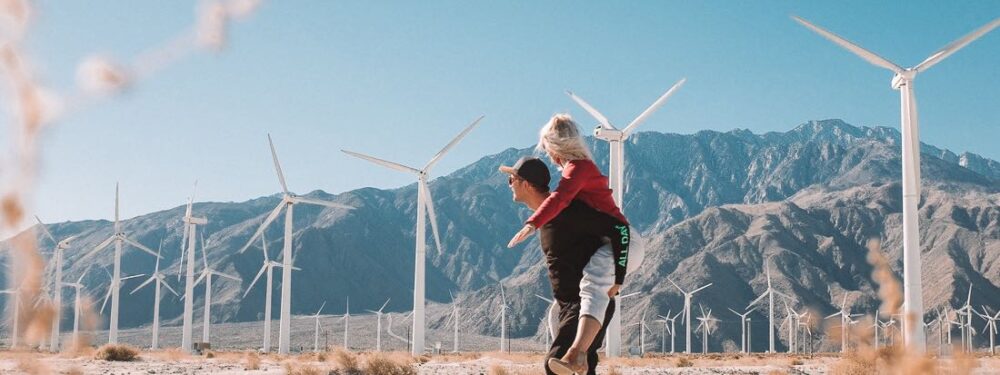
Your energy footprint
What is your energy footprint? It is the total energy you use in your daily life to obtain and use goods and services. We use a staggering amount of energy in our daily life, even if we don’t see it.
There are three main types of “energy use”:
Commercial and Industrial
This is the energy needed to produce the commercial and industrial goods that we use on a daily basis. You can reduce it by buying fewer things, shopping locally and sourcing products from environmentally conscious companies.
Domestic
This is the energy we use in our homes, accommodation, and workplaces. You can reduce it by limiting your need for air conditioning (or keeping the temperature mild), having cooler showers or shorter ones, (heating water takes a lot of energy), minimise washing and drying clothes (and using the cool wash setting), and unplugging appliances and turning lights off when you are not using them.
Transport
Transport, whether personal or commercial, uses a lot of energy. You can reduce it by:
- buying local
- avoid flying
- Use public transport to get around
- Walk or bike ride in new cities.

6. Eco Friendly Transport
Let’s face it, traveling uses energy, and burning fossil fuels creates emissions. One of the major emissions is carbon dioxide. There is significantly more carbon dioxide being pumped into our air now than the world can keep up with (plants naturally absorb carbon). What is the best way to get around? Here are some ideas to help with your eco travel transportation.
- Walking – It is still the best low-impact form of travel. However, it is limited by time and oceans. Try a free city walking tour when you are in a destination or plan a hiking holiday.
- Cycling – it has a low carbon impact but is also great for your health and fitness. More cities are creating bike lanes which are a huge win. If you are worried about the distance, try an electric bike to help you get around!
- Trains – is one of the best forms of transport for personal Carbon (C02) emissions. They are very efficient, with a relatively low environmental impact. Try a Euro Rail monthly pass or an Amtrak (USA) monthly pass.
- Cars/Vans – At this moment, fossil fuels are the main driver of motor vehicles. However, there are alternatives, like electric cars that can reduce your carbon footprint or you can try “ride-share” options in apps like Uber.
- Airplanes – Planes, unfortunately, have the largest environmental impact for travelers, contributing heavily to climate change. If you are going to fly, fly as direct as possible, select fuel-efficient airlines (EU, US, AU) and carbon offset/inset your flight.
- Sailing – It is a fun experience and great for the environment as they use mostly renewable energy (the wind). Try using a platform like Crewbay to find a sailboat looking for an inexperienced crew

Carbon offsetting
When you carbon offset your flight, you are not eliminating your carbon waste. The same amount of carbon still enters our atmosphere whether you pay for the offset or not. However, the money you pay for offsetting goes into various project sets by registered carbon offsetting organisations.
Projects they work on usually include:
- An environmental/tree planting or protection program
- Renewable energy research and development
- Human development projects (building schools for children in developing countries, providing drinking water to villages, etc.)
Do planting trees absorb the carbon?
The most logical idea is that if you pay to plant trees as your offset, the trees will absorb the carbon from the air (and offset your trip).
The reality is “If you plant a tree, or plant a million trees, that doesn’t really solve the problem because the carbon has been emitted and it’s in the atmosphere. The trees may absorb some of the carbon dioxide, but then you have to maintain those trees. If they die, the carbon is released again and you’re back to square one.” – James Higham from the University of Otago in New Zealand.
Carbon insetting
So, is it worth paying for carbon offsetting your flight? The simple answer is, yes. Any positive action is better than no action at all. However, as an alternative to offsetting, a new trend of “insetting” is now a thing.
- Instead of paying an offsetting company to plant trees or provide solar panels to villages, try doing it yourself
- Convert your house to solar power, plant trees, reduce your meat intake

7. Ethical Travel
Ethical Travel is a term closely associated with eco tourism. There are some specific things to keep in mind while eco traveling.
Support and be mindful of local communities
It may seem like common knowledge to most, but there are many cases where tourists blatantly disregard local cultures and customs and, in some cases, act rudely towards local communities.
As an eco traveler, you must not only be mindful but be willing to take action. Be conscious of appropriate behaviors as a guest in another country or even state/town.
Ethical travel tips:
- Research the local customs
- Be friendly and respectful to the local people
- Support local businesses
- Be aware that in countries where children ask for money there can be a dark side of child exploitation that you may be encouraging
- Ask before taking photos of locals

Be aware of animal tourism
Animal exploitation for human interest and tourism is nothing new. It has been around since the Roman Empire.
There is a significant amount of animal mistreatment happening around the world to this day. Often it is behind closed doors, so tourists do not see it. As eco travelers it is up to us to be informed, be aware, and take action in our decision-making process. There are right ways and wrong ways to support animal tourism.
The main platforms for animal tourism include:
- Zoos
- Aquariums
- Sanctuaries
- Wild Interaction
- Circus
- Shows
- Fights
- Sale of exotic animals
- Photos with exotic animals
Animal tourism attractions to avoid
Some animal attractions are worse than others. If any “eco resort” or accommodation suggests tours to or has any of the following attractions on-site, you can be sure that the accommodation is not truly eco.
- Riding elephants
- Taking tiger selfies
- Walking lions
- Bear parks
- Holding sea turtles
- Performing dolphin shows
- Dancing monkeys
- Civets in coffee plantations
- Holding/kissing cobras
- Crocodile farms
- Circuses with animal shows
- Zoos with breeding programs
In most cases, animals used for public entertainment (riding, walking, holding, taking photos with) are taken from their families at young ages and are conditioned (by force) to act in a way that is appropriate around the public.
If you believe that animals have personalities/rights, then you must consider how they feel about being forced into these situations with no chance of escape. Eco travel, as mentioned is about minimising environmental damage or harm. This is equally true for wildlife.
Support sanctuaries not shows
There are a lot of grey areas when it comes to the subject of animal tourism. Eco travel, is about being aware and making conscious choices.
After safe, wild animal interactions. Sanctuaries and conservation parks are the next best form of animal tourism. ‘”A sanctuary is a facility that provides lifetime care for animals that have been abused, injured, abandoned, or otherwise in need’ (GFAS, Global Federation of Animal Sanctuaries).
If an animal is in some kind of compound or captivity for any other reason than the above mentioned, it is not a “true sanctuary” (it could be a kind of zoo).

8. Eco Tours
If you are looking to travel to somewhere like South Africa or New Zealand and want to join an organised small group tour, there are options for “eco tours”.
There are only a few sites with global reach, which may give you some ideas of what kind of tours are available:
- World Wide Eco Tours – Covers mostly South America, Central America, South Africa and Japan.
In many cases, you can search online by the destination you want to go to and look for local tours and operators. Check their reviews to see how “eco” they really are or post a question to Tripadvisor’s Ecotourism Forum. There are daily updates and the online community is pretty well experienced.

9. The Eco Diet
There are far too many diets out there to say which one is best. Each person prefers their own, and some diets really are more suited to some people than others.
This is not a nutritional recommendation, however, it looks at food from an eco travel perspective. The process of making food uses energy, creates waste, and can have social or cultural ties. Here are some quick tips for the eco diet.
Eco Diet Tips
- Got dietary requirements – be prepared. Bring your own supplements.
- Eat local – Local is normally best.
- You get to experience different foods and support local communities
- Food sourced and produced locally, normally has a smaller energy and waste footprint than imported goods
- Snack on seeds – Sunflower seeds are great for long trips. They are one of the lowest water-consuming plants to grow, yet are full of nutrition and can curb your hunger when you arrive at a transportation terminal (with only fast food options available).
- Less meat – From an environmental perspective, meat uses significantly more water and energy to produce and also creates more waste than fruit and vegetables. You can find some great vegan and vegetarian restaurant guides for cities online.
- Cultural and Social Sensitivity – Be aware and be sensitive to local cultures. Refusing to eat a local dish or eating something outside of local customs can be extremely rude.
10. Learn Eco Travel Phrases In Other Languages
Supporting local communities on your travel means interacting in a positive way. One of the best ways to interact with locals is to try and speak their language. If you don’t have time to learn a new language before you arrive, it’s always nice to learn the pleasantries.
Even if you get it wrong, the fact that you’ve tried counts for a lot. When it comes to ordering food, getting around and specifically reducing your waste, conversations can become difficult.
To eco travel is to be active. This means being proactive against accepting unnecessary plastic. Not all cultures or towns or cities may be as aware of the plastic issue as you. It is not always their fault. Education plays a big part. What you can do is refuse, in the most polite way possible.

Ecotourism Phrases
We have compiled some of the most important travel phrases that you might need on the road and had them translated into different languages. You can keep the eBook handy on your phone and either learn the phrases or attempt the phrases and use them to point out if need be.
The languages available in the Eco Travel Guide ebook are:
- French
- German
- Dutch
- Russian
- Japanese
- Spanish
- Italian
- Simplified Chinese
- Hindi
- Portuguese
An example of the translation guide from the Eco Travel Guide ebook is shown in the image below.
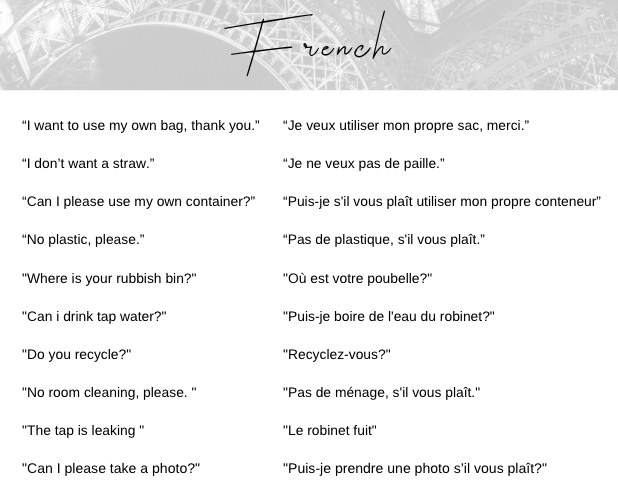
Point and share
Sometimes on your eco travel it can be easier to point out than it is to explain. Keep the Eco Travel Guide handy on your phone (in iBooks or in the PDF app for android) and get yourself out of forced plastic situations with a simple point and share.
The Eco Travel Point and Share section covers:
- Out and about
- At your accommodation
- Waste (trash) and recycling options
Ideally, we can have conversations and truly interact with locals in their language. But in some scenarios, you simply don’t have the time. The image below shows a sample of the eBook point and share page.
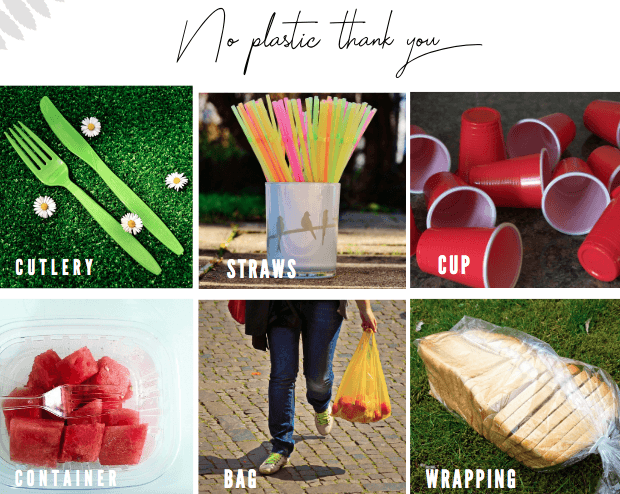
Eco Travel FAQ
What is the meaning of eco travel?
Eco travel involves exploring the world in a way that minimizes environmental impact and builds appreciation and conservation of natural and cultural resources.
How do I become an eco traveler?
Becoming an eco traveler starts with making sustainable choices, such as selecting accommodations that follow green practices, using public transportation, and supporting local economies.
Can eco tourism save the planet?
While eco-tourism alone can’t save the planet, it can significantly contribute to conservation efforts and awareness, promoting more sustainable travel behaviors globally.
What is eco travel?
Eco travel is a form of tourism that aims to be environmentally responsible, supporting the conservation of nature and the well-being of local communities.
Is train travel more environmentally friendly?
Train travel is generally more environmentally friendly compared to air or car travel, as trains emit significantly lower amounts of greenhouse gases per passenger mile.
What are some eco-friendly travel tips or destinations?
You can also explore the world responsibly by visiting eco-friendly destinations. There has been a push for conservation efforts in San Jose del Cabo in Mexico, San Pedro La Laguna in Guatemala is a zero waste town, Costa Rica is renowned for its rich biodiversity and extensive conservation efforts, and in Europe, Copenhagen has aimed to become the world’s first carbon-neutral capital by 2025 providing a green city experience. Adopt eco-friendly travel tips such as carrying reusable items and choosing overland transportation when possible.
What are the benefits of eco-sustainable tourism for local communities?
Eco-sustainable tourism helps stimulate local economies through job creation and the use of local services and products, while also empowering communities through education and conservation initiatives.
What are some eco-friendly travel tips for minimizing your environmental impact?
To minimize your environmental impact, you can travel during off-peak seasons, stay in eco-certified accommodations, use public transport, and reduce waste.
Join The Eco Travel Community
Got any ideas on eco travel? Had experiences overseas and found tips for certain locations?
Share them! Spread the word!
Pinterest is an amazing place where people come together from around the world to share eco travel and sustainable travel tips. Here is a list of the Best Eco & Sustainable Pinterest Group Boards and how to join them!
Free download – Eco Travel. The Ultimate Guide (ebook)
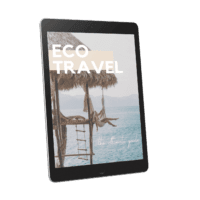
Sign up for our free Eco Travel ebook! It’s filled with tips on what to pack, where to go, and what to do, so you can travel in a more sustainable way!
We’ve also got eco friendly phrases translated into 10 different languages to help you communicate when you travel the globe! Download Here
Like This Article? Pin it!
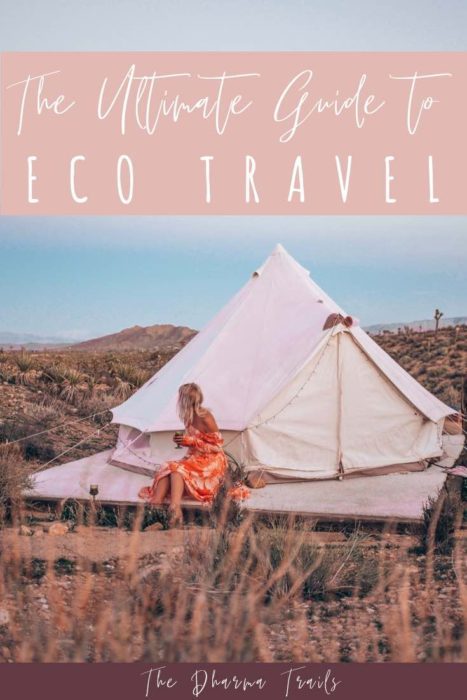
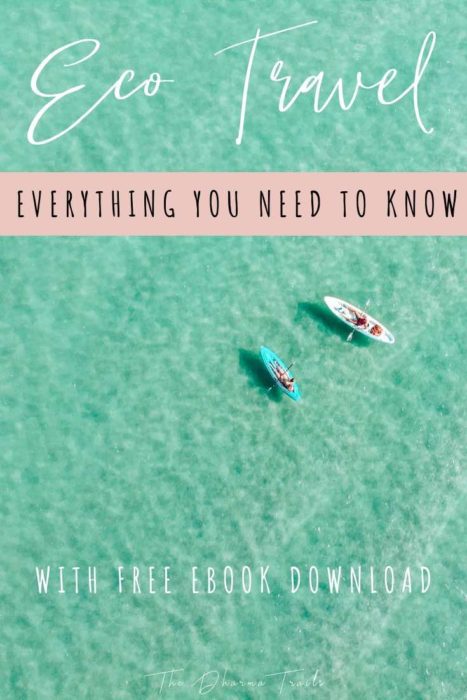
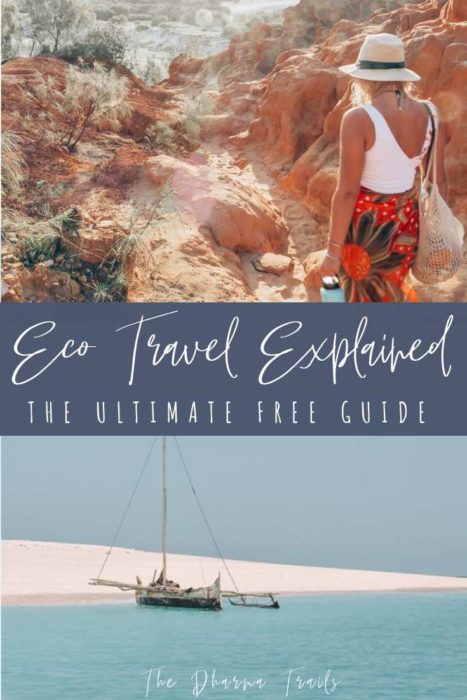

Aaron is one of the co-founders of The Dharma Trails. His background in marine eco tourism and writing have blended together to create the eco travel platform read by users around the world.

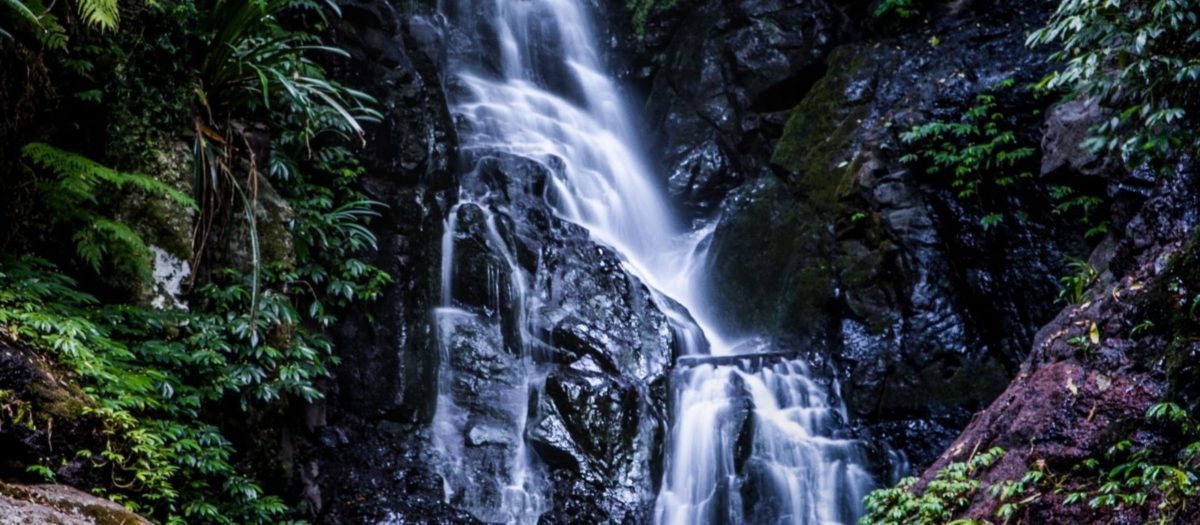

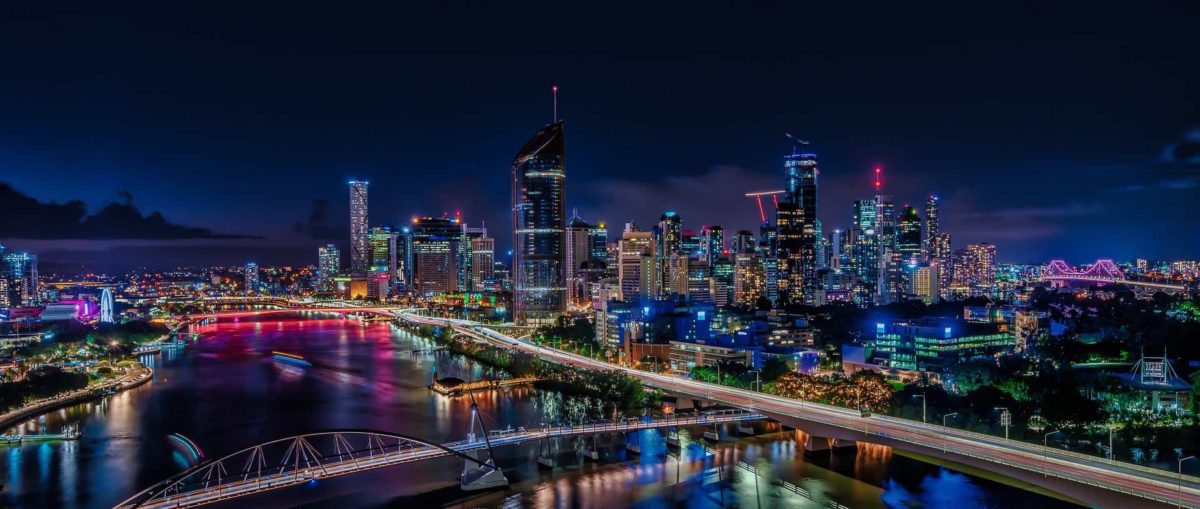
Super helpful! So great that you’ve created an easy guide with so many helpful points. Thank you!
Thanks! Glad that there was some useful points in there for you!
Thanks for the great read. Travelling soon, will take some points on board for sure. Keep up the great work, maybe one day the Australian government will follow lol
Thank you!
Great to know that more people are interested in eco travel!
Wow! This is amazing guys! Will make sure to remember on my next holidays! 🙂
Thanks! Glad there was some useful information in there for you!
Enjoy that holiday.
Thanks for the information, I will check out your link!
Wow! This is such a comprehensive guide. Thanks for sharing your information. They are very useful content. It was amazing.
Thanks so much. There’s definitely a lot of information in there. Glad you found it useful.
Cheers
Aaron
Very nice and helpful.
Thanks, we appreciate it!